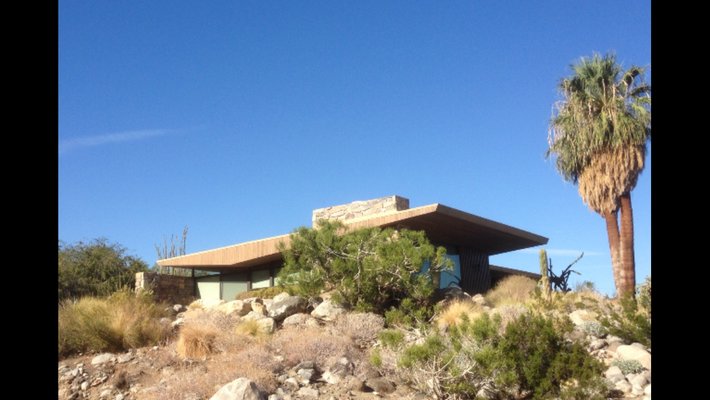
My grandmother’s 1936 Merriam-Webster’s Collegiate Dictionary, from which I often quote, doesn’t have a definition for “modernist” or modernism” in the contemporary architectural context. It does however define “modern” as “of, or characteristic of, the present,” which nicely suffices for my purposes.
I recently visited Palm Springs, California, over “Modernist Weekend” where modern homes, both from the 20th century as well as newly built, were open to tour. It was, in fact, a tour de force of modernist residential architecture.
From “Sunnylands,” the sprawling Annenberg Retreat designed by architect Quincy A. Jones in the mid 1960s, to the petite Frey House II of 1963 perched on a rock outcropping overlooking the valley, each home on the tour defined, and redefined, what it means to be a modern home.
Of course the climate in Palm Springs contributes to the many tenets often associated with modernism: horizontality, vast expanses of glass, interior and exterior materials used interchangeably, open and flowing shared spaces, and an interconnection with the landscape and views beyond. In fact this last characteristic—views—was the fulcrum on which most of the homes I toured turned. Whether in the valley, where the view was to the omni-present backdrop of resplendent mountains, or on the mountain with the drama of the valley, particularly at night, at your feet, the view in question provided a key ingredient to the buildings’ overall orientation and subsequent success.
And notably, nothing either on or off the tour hinted at the notion of a cookie-cutter McMansion so prevalent on the East End. Not one single attempt at a swooping gambrel roof was to be found.
To a house, the new construction, regardless of style, can only be described as modern, in the Merriam-Webster sense. How refreshing.
It’s as if what started in the 1940s as a style never went out of favor. If one looks at some of the earliest examples of modern homes in Palm Springs, they still feel new and current.
Certainly, materials have been improved upon over the decades with more energy-efficient windows and insulated wall- and ceiling panels. But the basic materials of steel, glass, aluminum, stone, brick, terrazzo and concrete find unique and ever-evolving applications in the many architectural talents practicing in the Palm Springs region.
I was also pleased to see many well-known modernist homes visible from the street, and not walled off by masonry walls or hedges. Most notably, one of modernism’s most photographed homes, the Kaufmann House of 1946 by Richard Neutra, turns an animated and highly articulated face toward the street, just as engaging as its famous poolside profile.
The Edris House, designed by Stewart Williams in 1954, provides a full frontal view to any and all passersby from high on its rocky top. And what about that fabulous sleek residence with the discrete entrance? Why Dinah Shore’s home, of course.
It was quite a step back in time. As was my recent and long overdue visit to the Philip Johnson Glass House in New Canaan, Connecticut.
Why had it taken so long for me to visit this nearby landmark? I have visited Monticello and Fallingwater (both twice), Taliesin West and East, plus innumerable well-known architectural landmarks over the years, but could not quite make it to New Canaan.
It was, however, worth the wait. It also seemed apropos to include it in this column as the Glass House was built at the same time, 1948, as many of the homes described above, and feels just as modern as anything being built anywhere today. No desert clime here, yet many of the same architectural concepts are employed with equal dexterity and aplomb, including the concept of a view.
Without its pastoral New England landscape, the success of the Glass House would be largely truncated, as it acts as a proscenium through which one sees, uninterrupted, the majesty of its surroundings. It is indeed a triumph of architectural siting, expression and execution.
All said, it’s been quite a year of seeing, touching and feeling modern residential architecture, including visits to the Eames and Stahl houses in Los Angeles, California, which were recounted in this column earlier this year. For anyone interested in architecture, there are many notable and famous homes available for touring, which should be a part of one’s vacation and business travel planning regardless of the destination. The list is long, and time is short, so begin now to plan your own trip back to the future.
Next time: Is Black the New White?